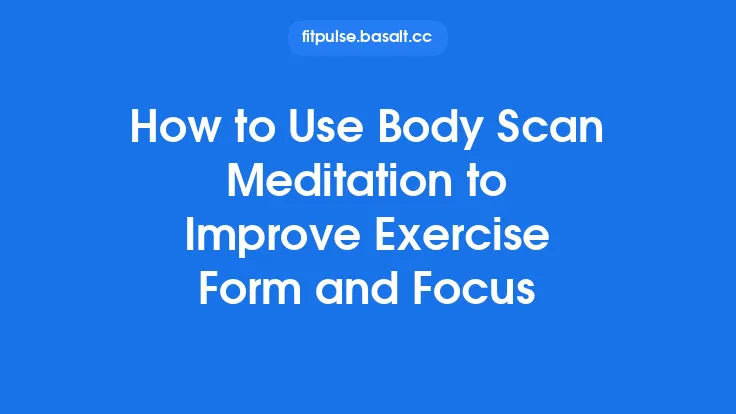Improving the ability to reach overhead, around objects, and bend down to pick things up is a cornerstone of functional independence. Whether you’re retrieving a book from a high shelf, tying your shoes, or gardening, the combination of shoulder, spine, hip, and ankle mobility determines how comfortably and safely you can perform these everyday actions. This article breaks down the anatomy, common limitations, assessment methods, and evidence‑based strategies to expand your reach and bend capacity, all while keeping the focus strictly on the mechanics of these movements.
Understanding Reach and Bend in Daily Life
Reach primarily involves the shoulder complex (glenohumeral joint, scapulothoracic articulation, and the thoracic spine) and the elbow. When you lift your arm overhead, the shoulder must achieve a high degree of flexion and abduction, while the scapula rotates upward and posteriorly to create space for the humeral head.
Bend encompasses lumbar and thoracic flexion, hip flexion, and ankle dorsiflexion. A smooth, coordinated bend starts with a slight ankle dorsiflexion, followed by hip flexion, and finally lumbar flexion. The pelvis tilts anteriorly, allowing the spine to round safely without excessive stress on intervertebral discs.
Both actions rely on a balance of flexibility (muscle‑tendon length), joint range of motion (ROM), and strength (muscle control). When any component is compromised, compensations arise—often leading to discomfort, reduced efficiency, or injury.
Common Limitations and Their Impact
| Area | Typical Restriction | Functional Consequence |
|---|---|---|
| Shoulder Flexion/Abduction | Tight posterior capsule, pectoralis minor, or latissimus dorsi | Inability to reach high shelves, overhead storage, or perform overhead chores |
| Scapular Upward Rotation | Weak serratus anterior or rhomboids, stiff thoracic spine | Limited arm elevation, shoulder impingement risk |
| Thoracic Extension | Rounded thoracic posture, tight erector spinae | Reduced reach forward, compromised posture during bending |
| Hip Flexion | Tight hip flexors (iliopsoas, rectus femoris) | Difficulty squatting, picking objects from the floor |
| Ankle Dorsiflexion | Limited calf flexibility, joint stiffness | Poor squat depth, increased forward lean during bending |
| Lumbar Flexibility | Stiff erector spinae, disc degeneration | Restricted forward bend, reliance on hip hinge, potential low‑back strain |
Identifying which of these limitations affect you is the first step toward targeted improvement.
Assessing Your Current Mobility
A quick self‑assessment can pinpoint the limiting joints:
- Shoulder Overhead Reach
- Stand with feet shoulder‑width apart. Raise one arm straight overhead, keeping the elbow locked. Measure the distance between the fingertip and the opposite ear. A gap > 2 cm suggests limited shoulder flexion or scapular upward rotation.
- Wall Angel Test (Thoracic Mobility)
- Back against a wall, elbows at 90°, forearms touching the wall. Slide arms upward. Inability to keep forearms flat indicates thoracic extension deficits.
- Sit‑and‑Reach for Hip Flexion
- Sit on the floor with legs extended. Reach forward toward the toes. Inability to touch the toes (or a short distance) may reflect limited hamstring or lumbar flexion, but a separate hip flexion test (knee‑to‑chest while supine) isolates the hip.
- Ankle Dorsiflexion Lunge
- Kneel with one foot forward, knee over the ankle. Attempt to bring the knee past the toe without the heel lifting. A short distance (< 5 cm) signals limited ankle dorsiflexion.
- Lumbar Flexion Test
- Stand, place hands on hips, and slowly bend forward, keeping knees straight. Observe the amount of spinal rounding versus hip hinge. Excessive lumbar rounding early on suggests limited hip flexion.
Record the results; they will guide the selection of stretching, strengthening, and mobility drills.
Stretching Strategies to Enhance Reach
1. Posterior Shoulder Capsule Stretch (Sleeper Stretch)
- Position: Lie on the side of the limited shoulder, arm flexed 90° in front of you, elbow at 90°.
- Action: Use the opposite hand to gently press the forearm toward the floor, feeling a stretch in the posterior capsule.
- Dosage: 3 sets of 30 seconds, 2‑3 times per day.
2. Pectoralis Minor Stretch (Doorway)
- Position: Stand in a doorway, forearms on the frame at shoulder height.
- Action: Step forward, allowing the chest to open while keeping the spine neutral.
- Dosage: 2‑3 sets of 45 seconds, especially after upper‑body work.
3. Thoracic Extension over Foam Roller
- Setup: Place a foam roller horizontally under the upper back, perpendicular to the spine.
- Action: Support the head, gently extend over the roller, allowing the thoracic vertebrae to articulate.
- Dosage: 1‑2 minutes, 3‑4 times weekly.
4. Hip Flexor Stretch (Kneeling Lunge)
- Position: Kneel on one knee, other foot forward, knee at 90°.
- Action: Tuck the pelvis under (posterior pelvic tilt) and gently push the hips forward.
- Dosage: 3 × 30 seconds per side, daily.
5. Calf‑Achilles Stretch (Wall)
- Position: Stand facing a wall, one foot forward, the other back with heel on the ground.
- Action: Lean into the wall, keeping the back knee straight, feeling a stretch in the calf.
- Dosage: 3 × 45 seconds per leg, after activity.
Key tip: Stretch in a controlled manner, avoiding bouncing (ballistic) movements. Hold each stretch at the point of mild tension, not pain.
Strengthening Exercises to Support Bending
Mobility gains are consolidated when the surrounding musculature can control the new range.
1. Scapular Upward Rotation – Serratus Anterior Push‑Ups
- Execution: In a plank position, protract the scapulae by pushing the floor away, feeling the serratus engage.
- Progression: Start on knees, advance to full plank.
- Reps: 3 × 12‑15.
2. Overhead Shoulder Press (Dumbbell) – Emphasizing Full ROM
- Execution: From a seated or standing position, press dumbbells from shoulder height to full extension, maintaining scapular upward rotation.
- Reps: 3 × 8‑10, moderate load.
3. Hip Flexor Strength – Standing March with Resistance Band
- Setup: Loop a light band around the ankle, anchor behind you.
- Action: Lift the knee against band resistance, keeping torso upright.
- Reps: 3 × 12 per side.
4. Ankle Dorsiflexor Activation – Seated Heel Raises
- Execution: Sit with feet flat, lift the toes while keeping heels on the ground, focusing on tibialis anterior contraction.
- Reps: 3 × 15‑20.
5. Core Bracing for Lumbar Flexion – Dead Bug
- Execution: Lie on back, arms toward ceiling, knees bent 90°. Extend opposite arm and leg while maintaining a neutral spine.
- Reps: 3 × 10 per side.
These exercises develop the stabilizing capacity needed to protect joints when you reach farther or bend deeper.
Myofascial Techniques and Self‑Massage
Tight fascia can limit ROM even when muscles appear flexible. Simple self‑myofascial release (SMR) can complement stretching:
- Lacrosse Ball for Posterior Shoulder – Place the ball under the posterior deltoid, roll gently to release tension.
- Foam Roller for Thoracic Spine – Perform slow, controlled rolls for 1‑2 minutes, focusing on areas of restriction.
- Theracane for Hip Flexors – Apply pressure along the iliopsoas line while breathing deeply.
Spend 30‑60 seconds on each target area, 2‑3 times per week. Avoid excessive pressure that provokes sharp pain.
Integrating Mobility Work into Daily Tasks
The most sustainable improvements happen when mobility drills are woven into routine activities:
| Daily Situation | Mini‑Mobility Cue |
|---|---|
| Reaching for a high cabinet | Perform a quick “wall angel” while waiting for the microwave. |
| Picking up laundry from the floor | Do a 5‑second ankle dorsiflexion lunge before bending. |
| Putting on shoes | Execute a seated hip flexor stretch while tying laces. |
| Cleaning a countertop | Alternate shoulder flexion stretches between countertop wipes. |
By pairing a functional task with a targeted mobility cue, you reinforce the movement pattern and gradually expand the usable range.
Progression and Monitoring
- Baseline Recording – Document initial ROM measurements (e.g., shoulder flexion angle, ankle dorsiflexion distance).
- Weekly Check‑Ins – Re‑measure the same parameters every 7‑10 days. Expect 5‑10 % improvements in the first month if consistency is maintained.
- Load Management – Increase stretch hold time or add light resistance once a stretch feels easy for three consecutive sessions.
- Pain Surveillance – Mild discomfort is normal; sharp or radiating pain warrants a pause and possible professional evaluation.
A simple log (paper or app) helps visualize progress and keeps motivation high.
Frequently Asked Questions
Q: How long does it take to notice a difference in my ability to reach overhead?
A: Most individuals report a perceptible increase in reach after 2‑3 weeks of daily stretching combined with scapular strengthening, provided they adhere to the prescribed frequency.
Q: Can I improve my bend without compromising my lower back?
A: Yes. Emphasizing hip flexion and ankle dorsiflexion first reduces the load on lumbar discs. Use a hip‑dominant hinge (think “sit‑back” motion) before allowing lumbar flexion.
Q: Are there any contraindications for these stretches?
A: Individuals with recent shoulder dislocation, severe rotator cuff tears, or acute lumbar disc herniation should consult a healthcare professional before initiating overhead or deep bending stretches.
Q: Should I use equipment like resistance bands or can bodyweight suffice?
A: Bodyweight is adequate for beginners. Bands add progressive overload and are useful once you can comfortably achieve the full ROM without pain.
Closing Thoughts
Expanding your reach and bend capacity is a blend of anatomical awareness, targeted flexibility work, strength conditioning, and practical integration into everyday life. By systematically assessing limitations, applying evidence‑based stretches, reinforcing the new range with appropriate strengthening, and reinforcing the patterns during routine tasks, you create a resilient functional foundation. The result is not just the ability to grab that top‑shelf jar or pick up a dropped pen, but a lasting improvement in confidence and independence for all daily activities.





